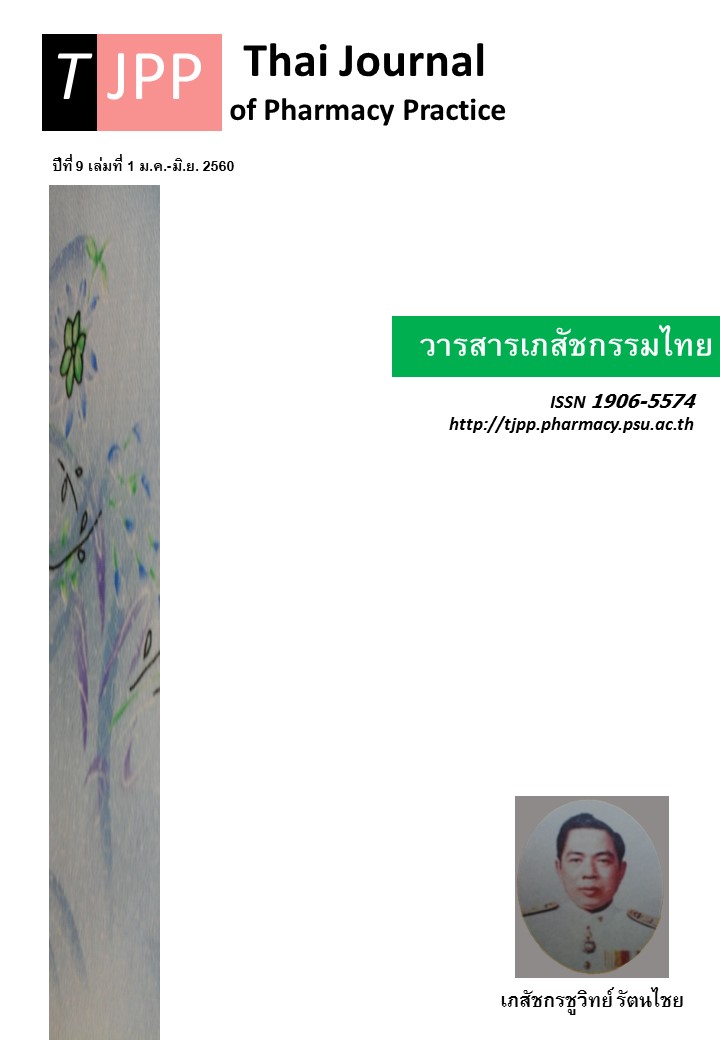อุบัติการณ์และปัจจัยเสี่ยงต่อการเกิดภาวะเม็ดเลือดขาวนิวโทรฟิลต่ำใน ผู้ป่วยมะเร็งเต้านมที่รับยาเคมีบำบัดทางหลอดเลือดดำ ณ โรงพยาบาลจุฬาลงกรณ์
Main Article Content
บทคัดย่อ
วัตถุประสงค์: เพื่อศึกษาอุบัติการณ์และปัจจัยเสี่ยงต่อการเกิดภาวะเม็ดเลือดขาวนิวโทรฟิลต่ำในผู้ป่วยมะเร็งเต้านมที่ได้รับยาเคมีบำบัดทางหลอดเลือดดำ วิธีการ: การวิจัยเชิงสำรวจแบบเก็บข้อมูลย้อนกลับ (observational retrospective cohort study) โดยทบทวนเวชระเบียนผู้ป่วยนอก 380 คน ที่มีอายุ ≥18 ปี ซึ่งได้รับวินิจฉัยว่าเป็นมะเร็งเต้านมระยะที่ 1-3 และได้รับยาเคมีบำบัดทางหลอดเลือดดำเป็นครั้งแรก การวิเคราะห์ความสัมพันธ์ระหว่างปัจจัยเสี่ยงและระยะปลอดเหตุการณ์ ใช้ Cox proportional hazards regression ผลการวิจัย: จากกลุ่มตัวอย่าง 380 คน พบว่า 23 คนได้รับ granulocyte-colony stimulating factor (G-CSF) เพื่อป้องกันแบบปฐมภูมิซึ่งมีผลต่อการเพิ่มระดับเม็ดเลือดขาวนิวโทรฟิล การศึกษานี้จึงตัดกลุ่มผู้ป่วยดังกล่าวออก การศึกษาในกลุ่มตัวอย่าง 357 คน พบว่า ร้อยละ 72.55 (n=259) เกิดภาวะเม็ดเลือดขาวนิวโทรฟิลต่ำระดับ 2 ขึ้นไป (ANC<1.5x109neutrophils/L) และร้อยละ 57.70 (n=206) เกิดหลังได้รับยารอบแรก อัตราอุบัติการณ์คิดเป็น 9.7 ต่อ 100 คน-สัปดาห์ ปัจจัยเสี่ยงการเกิดภาวะเม็ดเลือดขาวนิวโทรฟิลต่ำ ได้แก่ สูตรยาเคมีบำบัด (P=0.002) ไม่พบความสัมพันธ์อย่างมีนัยสำคัญทางสถิติระหว่างอายุ ดัชนีมวลกาย โรคร่วม ระยะของโรค และผลตรวจทางห้องปฏิบัติการเริ่มต้นกับระยะปลอดเหตุการณ์ ยาสูตรที่มี doxorubicin และ cyclophosphamide (AC based) มีโอกาสในการเกิดภาวะเม็ดเลือดขาวนิวโทรฟิลต่ำเพิ่มขึ้น 1.7 เท่าเมื่อเทียบกับสูตรที่ไม่มี AC based สรุป: การศึกษาพบอุบัติการณ์การเกิดภาวะเม็ดเลือดขาวนิวโทรฟิลต่ำหลังได้รับยาเคมีบำบัดสูง (ร้อยละ 72.55) และมากกว่าครึ่งหนึ่งเกิดหลังได้รับยารอบแรก ดังนั้น ควรมีการติดตามและให้การป้องกันอย่างเหมาะสมในผู้ป่วยที่ได้รับยารอบแรกหรือผู้ป่วยที่ได้รับยาสูตร AC based
Article Details
ผลการวิจัยและความคิดเห็นที่ปรากฏในบทความถือเป็นความคิดเห็นและอยู่ในความรับผิดชอบของผู้นิพนธ์ มิใช่ความเห็นหรือความรับผิดชอบของกองบรรณาธิการ หรือคณะเภสัชศาสตร์ มหาวิทยาลัยสงขลานครินทร์ ทั้งนี้ไม่รวมความผิดพลาดอันเกิดจากการพิมพ์ บทความที่ได้รับการเผยแพร่โดยวารสารเภสัชกรรมไทยถือเป็นสิทธิ์ของวารสารฯ
เอกสารอ้างอิง
2. Ozer H. The timing of chemotherapy-induced neutropenia and its clinical and economic impact [online]. [cited August 3, 2015]. Available from: www.cancernetwork.com/oncology-journal/timing-chemotherapy-induced-neutropenia-and-its-clini cal -and-economic-impact.
3. Pettengell R, Schwenkglenks M, Leonard R, Bosly A, Paridaens R, Constenla M, et al. Neutropenia occurrence and predictors of reduced chemothe- rapy delivery: result from the INC-EU prospective observational European neutropenia study. Support Care Cancer 2008; 16: 1299-309.
4. Crawford J, Wolff D, Culakova E, Poniewierski MS, Selby C, Dale D, et al. First-cycle risk of severe and febrile neutropenia in cancer patients receiving systemic chemotherapy: results from a prospective nationwide study. Poster presented at the 46th Annual Meeting of the American Society of Hematology; December 4–7, 2004; San Diego, Calif. Abstract 2210.
5. Khan S, Dhadda A, Fyfe D, Sundar S. Impact of neutropenia on delivering planned chemotherapy for solid tumours. Eur J Cancer Care 2008; 17: 19-25.
6. Repetto L. Incidence and clinical impact of chemotherapy induced myelotoxicity in cancer patients: An observational retrospective survey. Crit Rev Oncol Hematol 2009; 72: 170-9.
7. Schwenkglenks M, Jackisch C, Constenla M, Kerger JN, Paridaens R, Auerbach L, et al. Neutropenic event risk and impaired chemothe- rapy delivery in six European audits of breast cancer treatment. Support Care Cancer 2006; 14: 901-9.
8. Leonard R, Miles D, Thomas R, Nussey F. Impact of neutropenia on delivering planned adjuvant chemotherapy: UK audit of primary breast cancer patients. Br J Cancer 2003; 89: 2062-8.
9. Koinis F, Nintos G, Georgoulias V, Kotsakis A. Therapeutic strategies for chemotherapy-induced neutropenia in patients with solid tumor. Expert Opin. Pharmacother 2015; 16: 1505-19.
10. Fontanella C, Bolzonello S, Lederde B, Aprile G. Management of breast cancer patients with chemotherapy-induced neutropenia or febrile neutropenia. Breast Care 2014; 9: 239-45.
11. Schouten HC. Neutropenia management. Ann Oncol 2006;17(Supplement 10):X85-9.
12. Lyman GH. Management of chemotherapy-induced neutropenia with colony-stimulating factors. Eur Oncol 2008;4:13-7.
13. National Comprehensive Cancer Network. Clinical practice guidelines in oncology (NCCN Guidelines ®) myeloid growth factors V2.2014 [online]. [cited April 21, 2015]. Available from: www.nccn.org/pro fessionals/physician_gls/f_guidelines.asp.
14. Aapro MS, Bohlius J, Cameron DA, Dal Lago L, Donnelly JP, Kearney N, et al. 2010 update of EORTC guidelines for the use of granulocyte-colony stimulating factor to reduce the incidence of chemotherapy-induced febrile neutropenia in adult patients with lymphoproliferative disorders and solid tumours. Eur J Cancer 2011; 47:8–32.
15. Freifeld AG, Bow EJ, Sepkowitz KA, Boeckh MJ, Ito JI, Mullen CA, et al. Clinical practice guideline for the use of antimicrobial agents in neutropenic patients with cancer: 2010 update by the Infectious Diseases Society of America. Clin Infect Dis 2011; 52:e56-93.
16. National Comprehensive Cancer Network. Clinical practice guidelines in oncology (NCCN Guidelines ®) prevention and treatment of cancer-related infections V2.2015 [online]. [Cited July 18, 2015]. Available from: www.nccn.org/professionals/physi- cian_gls/f_guidelines.asp.
17. World Health Organization. Thailand-cancer country profiles, 2014 [online]. [Cited April 19, 2016]. Available from: www.who.int/cancer/coun try -profiles/en/.
18. The National Cancer Institute of Thailand. Hospital-based cancer registry annual report 2012. Bangkok: Eastern Printing; 2014.
19. Cancer Registry Unit, National Cancer Institute Thailand. Cancer in Thailand 2015 Vol.VIII, 2010-2012. Bangkok: New Thammada Press; 2015.
20. Crawford J, Dale DC, Lyman GH. Chemotherapy-induced neutropenia: risks, consequences, and new directions for its management. Cancer 2004; 100: 228–37.
21. Schwenkglenks M, Pettengell R, Jackisch C, Paridaens, Constenla M, Bosly A, et al. Risk factors for chemotherapy-induced neutropenia occurrence in breast cancer
patients: data from the INC-EU prospective observational European neutropenia study. Support Care Center 2011; 19: 483-90.
22. Lyman GH, Lyman CH, Agboola O. Risk models for predicting chemotherapy-induced neutropenia. Oncologist 2005; 10: 427–37.
23. Ratanabunjerdkul H. Association between hypo- albuminemia and severe neutropenia followng the first cycle chemotherapy in breast cancer patients [Dissertation]. Bangkok: Chulalongkorn University; 2011.
24. Vanichbancha K. Data analysis with SPSS for windows. 7th ed. Bangkok: Thammasarn Press; 2003.
25. Fausel CA. Neutropenia and agranulocytosis. In: Tisdale JE, Miller DA, editors. Drug-induced diseases prevention, detection, and management. Maryland: American
Society of Health-System Pharmacist; 2005. p.671-81.
26. Keswara MA, Sudarsa IW, Golden N. The risk factor of neutropenia on locally advance breast cancer patients treated with first cycle cyclophosphamide, doxorubicin, 5-fluorouracil chemotherapy at Sanglah General Hospital Denpasar, Bali, Indonesia. Bali Med. J. 2012; 1: 116-20.
27. Bretzel RL, Cameron R, Gustas M, Garcia MA, Hoffman HK, Malhotra R, et al. Dose intensity in early-stage breast cancer: A community practice experience. J Oncol Pract 2009; 5: 287-90.
28 López-Pousa A, Rifà J, Casas Fernández de Tejerina A, González Larriba JL, Iglesias C, Gasquet JA, et al. Risk assessment model for first-cycle chemotherapy induced neutropenia in patients with solid tumours. Eur J Cancer Care 2010; 19: 648–55.


